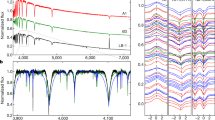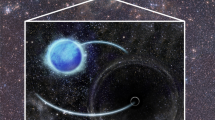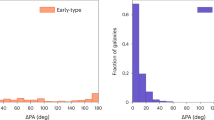Abstract
Only a few of the dozen or so known stellar-mass black holes have been observed away from the plane of the Galaxy1. Those few could have been ejected from the plane as a result of a ‘kick’ received during a supernova explosion, or they could be remnants of the population of massive stars formed in the early stages of evolution of the Galaxy. Determining their orbital motion should help to distinguish between these options. Here we report the transverse motion (in the plane of the sky) for the black-hole X-ray nova XTE J1118+480 (refs 2, 3, 4, 5), from which we derive a large space velocity. This X-ray binary system has an eccentric orbit around the Galactic Centre, like most objects in the halo of the Galaxy, such as ancient stars and globular clusters. The properties of the system suggest that its age is comparable to or greater than the age of the Galactic disk. Only an extraordinary ‘kick’ from a supernova could have launched the black hole into an orbit like this from a birthplace in the disk of the Galaxy.
This is a preview of subscription content, access via your institution
Access options
Subscribe to this journal
Receive 51 print issues and online access
$199.00 per year
only $3.90 per issue
Buy this article
- Purchase on Springer Link
- Instant access to full article PDF
Prices may be subject to local taxes which are calculated during checkout


Similar content being viewed by others
References
White, N. E. & van Paradijs, J. The Galactic distribution of black hole candidates in low-mass X-ray binary systems. Astrophys. J. 473, L25–L29 (1996).
Remillard, R., Morgan, E., Smith, D. & Smith, E. XTE J1118+480. IAU Circ. No. 7389 (2000).
Uemura, M. et al. Discovery and photometric observation of the optical counterpart in a possible Galactic halo X-ray transient, XTE J1118+480. Publ. Astron. Soc. Jpn 52, L15–L19 (2000).
McClintock, J. E. et al. A black hole of greater than 6 M⊙ in the X-ray nova XTE J118+480. Astrophys. J. 551, L147–L150 (2001).
Wagner, R. M. et al. The halo black hole X-ray transient XTE J1118+480. Astrophys. J. 556, 42–46 (2001).
McClintock, J. E. et al. Complete simultaneous spectral observations of the black-hole X-ray nova XTE J1118+480. Astrophys. J. 555, 477–482 (2001).
Pooley, G. G. & Waldram, E. M. XTE J1118+480. IAU Circ. No. 7390 (2000).
Dhawan, V., Pooley, G. G., Ogley, R. N. & Mirabel, I. F. XTE J1118+480. IAU Circ. No. 7395 (2000).
Fender, R. P. et al. Spectral evidence for a powerful compact jet from XTE J1118+480. Mon. Not. R. Astron. Soc. 322, L23–L27 (2001).
Hynes, R. I. et al. The X-ray transient XTE J1118+480: Multiwavelength observations of a low-state minioutburst. Astrophys. J. 539, L37–L40 (2000).
Johnson, D. R. H. & Soderblom, D. R. Calculating Galactic space velocities and their uncertainties. Astron. J. 93, 864–867 (1987).
Mihalas, D. & Binney, J. Galactic Astronomy 382–384 (Freeman, San Francisco, 1981).
Oort, J. H. Asymmetry in the distribution of stellar velocities. Observatory 49, 302–304 (1926).
Johnston, K. V., Hernquist, L. & Bolte, M. Fossil signatures of ancient accretion events in the halo. Astrophys. J. 465, 278–287 (1996).
Nelemans, G., Tauris, T. M. & van den Heuvel, E. P. J. Constraints on mass ejection in black hole formation derived from black hole X-ray binaries. Astron. Astrophys. 352, L87–L90 (1999).
Fryer, C. L. & Kalogera, V. Theoretical black hole mass distributions. Astrophys. J. 554, 548–560 (2001).
Toscano, M. et al. Millisecond pulsar velocities. Mon. Not. R. Astron. Soc. 307, 925–933 (1999).
Zahn, J.-P. Tidal friction in close binary stars. Astron. Astrophys. 57, 383–394 (1977).
Chiba, M. & Beers, T. C. Kinematics of metal-poor stars in the Galaxy. III. Astron. J. 119, 2843–2865 (2000).
Dauphole, B. et al. The kinematics of globular clusters, apocentric distances and a halo metallicity gradient. Astron. Astrophys. 313, 119–128 (1996).
Frontera, F. et al. A measurement of the broad-band spectrum of XTE J1118+480 with BeppoSAX and its astrophysical implications. Astrophys. J. (in the press).
Haswell, C. A. et al. XTE J1118+480. IAU Circ. No. 7407 (2000).
Kulkarni, S. R., Hut, P. & McMillan, S. Stellar black holes in globular clusters. Nature 364, 421–423 (1993).
Mirabel, I. F. & Rodríguez, L. F. Microquasars in our Galaxy. Nature 392, 673–676 (1998).
Grenier, I. A. in GeV-TeV Gamma Ray Astrophysics Workshop: Towards A Major Atmospheric Cherenkov Detector VI (eds Dingus, B. L., Salamon, M. H. & Kieda, D. B.) Vol. 515, 261–279 (American Institute of Physics, Melville, New York, 1999).
Acknowledgements
We thank G. Pooley for information on the fluxes observed with the Ryle telescope, A. Spagna for providing his astrometric software for the optical measurements, and R. Fernández for help with software programming. I.F.M. thanks J. Paul, J.-P. Zahn, R. M. Wagner, G. Israelian, R. Rebolo, E. Ergma and A. King for helpful comments and discussions. The National Radio Astronomy Observatory is a facility of the National Science Foundation operated under cooperative agreement by Associated Universities, Inc. The Guide Star Catalogue-II is a joint project of the Space Telescope Science Institute and the Osservatorio Astronomico di Torino with additional support provided by the European Southern Observatory, Space Telescope European Coordinating Facility, the International GEMINI project and the European Space Agency Astrophysics Division. I.F.M. is a member of the Consejo Nacional de Investigaciones Científicas y Técnicas of Argentina, and I.R. is a Fellow of the Conselho Nacional de Desenvolvimento Científico e Technológico of Brazil.
Author information
Authors and Affiliations
Corresponding author
Rights and permissions
About this article
Cite this article
Mirabel, I., Dhawan, V., Mignani, R. et al. A high-velocity black hole on a Galactic-halo orbit in the solar neighbourhood. Nature 413, 139–141 (2001). https://doi.org/10.1038/35093060
Received:
Accepted:
Issue Date:
DOI: https://doi.org/10.1038/35093060
This article is cited by
-
Faint objects in motion: the new frontier of high precision astrometry
Experimental Astronomy (2021)
-
Jet–Environment Interactions as Diagnostics of Jet Physics
Space Science Reviews (2014)
Comments
By submitting a comment you agree to abide by our Terms and Community Guidelines. If you find something abusive or that does not comply with our terms or guidelines please flag it as inappropriate.



